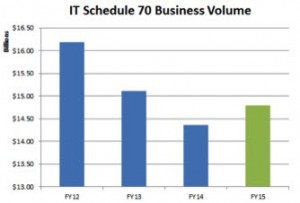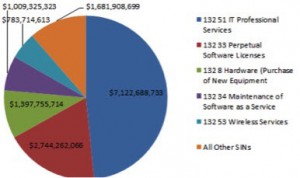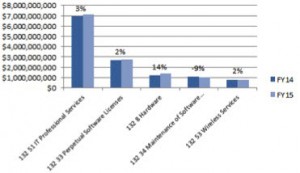Recently, I talked about how important it is to keep up with the latest technology trends and changes taking place across government for purchasing IT products and services. ITS continually strives to streamline procurement processes and maximize federal spending to achieve better acquisition and operational efficiencies for government agencies while at the same time acting as effective stewards of taxpayer dollars.
One great example of how we’ve been able to do just that for IT hardware products is the Government-wide Strategic Solution (GSS) for Desktops and Laptops. This particular project focused on key areas of importance to me: leveraging the buying power of the federal government, collaborating with other federal agencies and industry, and creating acquisition efficiency.
Leveraging Our Buying Power
First, the Office of Management and Budget (OMB) recognized an opportunity for the government to improve how we buy IT hardware and issued a memo on October 16, 2015 mandating that all civilian agencies use three existing “Best in Class” vehicles to fulfill most of their laptop and desktop needs. OMB stated that cross-agency collaboration and industry feedback were the keys to taking full advantage of the government’s buying power in this space.
Inter-Agency Collaboration
Second, based on the need for increased collaboration and integration between services, OMB created the Workstations Commodity Team (WCT), now known as the Workstation Category Team (WCT). The WCT comprises IT and procurement professionals from NASA, the General Services Administration (GSA), and the National Institutes of Health (NIH). The group spent over two years working with our industry partners and a consortium of over 20 federal agencies to develop a framework and strategy for solving some of the issues, like limited transparency and terms and conditions that were not common, that the government was facing in the IT hardware space.
As a result of the great cross-agency collaboration and in consultation with OMB, the Government-wide Strategic Solution (GSS) for Desktops and Laptops was developed. On February 2, 2016, GSA, NASA, and NIH hosted an industry day. We used this forum to share the updated specifications with industry and to seek their input for moving forward with the first technical refresh under the effort.
Efficiency
Lastly, the GSS currently gives agencies a choice of three desktop and three laptop configurations that meet the federal government’s requirements for more than 80 percent of systems purchased.
In addition to the six standard configurations, GSS for Desktops and Laptops has pre-negotiated policies and terms and conditions, and includes significant small business participation–over 85 percent, ensuring that agencies save time and meet socioeconomic goals.
A significant feature of the GSS for Desktops and Laptops is the continued focus on keeping up with fast-paced technology change. The program incorporates a technical refresh schedule every nine months, so specifications reflect feedback from customer agencies and industry, aligning available configurations to market conditions and available technology.
Current configurations are now available for purchase on all three contracts. You can access the configurations on GSA Advantage and see all three contracts on the Acquisition Gateway.
By using existing best-in-class contract vehicles, streamlining procurement processes, and maximizing federal spend, we not only achieve better acquisition and operational efficiencies but also act as one and as effective stewards of taxpayer dollars.
The Challenge
Just to give you some perspective on how significant this particular initiative is, in fiscal year 2014 alone, federal agencies awarded more than 10,000 individual contracts and delivery orders for desktops and laptops, totaling approximately $1.1 billion. These products’ prices varied by almost 300 percent. If agencies requested different configurations, the prices went up even more.
Next Steps
On June 1, 2016, OMB released a GSS Desktop/Laptop buying event announcement to the CIO/CAO communities to increase awareness and encourage agency participation in the GSS initiative. GSA, NASA, and NIH will each conduct buying events for laptops and desktops between June and September 2016. The planned buying events are in support of OMB Memo M-16-02, Improving Demand Management Practices (Aggregate demand to support leveraged buying events).
Accordingly, GSA IT Schedule 70 will conduct its first buying event during 4th Quarter 2016. GSA will request federal agencies to provide estimated quantities by June 17, 2016, in order to obtain maximum volume discounts, which will streamline agency buying and drive down costs.
GSA’s acquisition will be conducted through the GSA Reverse Auction Platform based on estimated agency requirements, resulting in awards for manufacturer-specific, single-award government-wide Blanket Purchase Agreements (BPAs) for each of the six GSS standard-configurations to the Original Equipment Manufacturer (OEM) authorized resellers. These BPAs will be made accessible via the GSA AdvantageSelect platform, which allows agencies to purchase online without further competition.
ITS will continue to add new industry partners that offer the standard configurations and encourage small business participation. You can also use the GSA Advantage GSS icon  to identify products meeting the minimum specification on GSA Advantage.
to identify products meeting the minimum specification on GSA Advantage.
To learn more about the program and how to order, visit the GSS for Desktops and Laptops webpage.
Please follow us on Twitter @GSA_ITS and LinkedIn to join our ongoing conversations about government IT.


